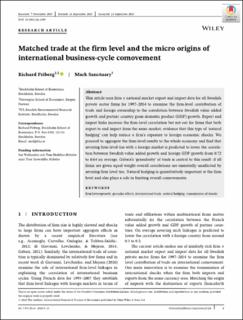Matched trade at the firm level and the micro origins of international business-cycle comovement
Peer reviewed, Journal article
Published version
Permanent lenke
https://hdl.handle.net/11250/2720732Utgivelsesdato
2020Metadata
Vis full innførselSamlinger
- Articles (SAM) [119]
- Publikasjoner fra CRIStin (NHH) [249]
Sammendrag
This article uses firm × national market export and import data for all Swedish
private sector firms for 1997–2014 to examine the firm-level contribution of
trade and foreign ownership to the correlation between Swedish value added
growth and partner country gross domestic product (GDP) growth. Export and
import links increase the firm-level correlation but net out for firms that both
export to and import from the same market, evidence that this type of ‘natural
hedging’ can help reduce a firm's exposure to foreign economic shocks. We
proceed to aggregate the firm-level results to the whole economy and find that
severing firm-level ties with a foreign market is predicted to lower the correlation between Swedish value added growth and foreign GDP growth from 0.72
to 0.64 on average. Gabaix's ‘granularity’ of trade is central to this result: if all
firms are given equal weight overall correlations are essentially unaffected by
severing firm level ties. Natural hedging is quantitatively important at the firm
level and also plays a role in limiting overall comovements.

